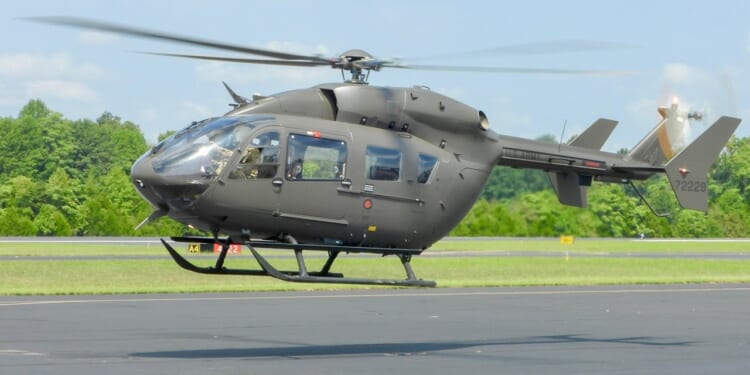The UH-72 Lakota is a transport helicopter for the US Army, lauded for its ease of use, low maintenance costs, and forgiving flight characteristics.
The Airbus UH-72 Lakota is an unheralded yet indispensable workhorse for the US Army. Designed not for front-line combat but for the monotonous demands of transport, training, and civil support, the UH-72 receives far less recognition than its contemporaries the UH-60 Black Hawk or AH-64 Apache. But without the invaluable services of the UH-72 behind the front lines, the Army’s operational efficiency would grind to a halt.
The UH-72 Lakota’s Specifications
- Year Introduced: 2007
- Number Built: ~480
- Length: 42 ft 7 in (13.00 m)
- Rotor Diameter: 36 ft 1 in (11.00 m)
- Weight (MTOW): ~7,903 lb (3,585 kg)
- Engines: Two Safran (Turbomeca) Arriel 1E2 turboshafts (~738 shp each)
- Top Speed: ~145 knots (~167 mph, 268 km/h)
- Range: ~360 nautical miles (414 mi, 667 km); ~3.5 hours’ endurance
- Service Ceiling: ~18,000 ft (5,490 m)
- Loadout: None (unarmed); configurable mission kits for MEDEVAC, cargo hook, rescue hoist, sensors and communications
- Aircrew: 2 (pilot and co-pilot)
The helicopter’s cockpit is glass, featuring dual Garmin GNS 530 systems and digital flight displays—reflecting the airframe’s commercial origins with a user-friendly, easily trainable, and FAA compatible layout.
The modular cabin design allows for rapid reconfiguration depending on the mission profile. The UH-72 can be rearranged for cargo, passenger, and medevac roles in minutes.
Conveniently, the helicopter’s operating costs are quite low—around a third that of the UH-60 Black Hawk—making the UH-72 ideal for training and routine missions.
The UH-72 lacks the armor, armament, and survivability features of the Black Hawk, confining it to relatively benign environments. In a combat zone, the helicopter would be highly vulnerable to enemy ground fire, and the Army has assiduously kept it away from the front lines of its recent conflicts.
Why the US Army Wanted the UH-72 Lakota
Despite its Native American moniker, the UH-72 Lakota was born from the European-based Eurocopter EC145, a civilian utility helicopter developed in the late 1990s by Eurocopter (now Airbus Helicopters).
The US Army, in an effort to modernize an aging fleet of UH-1 Hueys and OH-58 Kiowas, pursued a Light Utility Helicopter (LUH) program for non-combat missions, which was focused on cost, reliability, and commercial off-the-shelf readiness rather than flashy or innovative design. In 2006, the LUH program culminated in the Army’s selection of the EC145, which then received the UH-72 Lakota designation, named for the Native American Lakota Nation. Production began at Airbus’s facility in Columbus, Mississippi, with final assembly and testing handled domestically.
The Army’s goal, in selecting the UH-72 was straightforward: to free up its combat-ready UH-60s and AH-64s by assigning less demanding roles such as medevac, VIP transport, and training, to a simpler and cheaper airframe. In the two decades since, the UH-72 has become a cornerstone of the Army’s National Guard and homeland-security operations, providing a bridge between military and civil aviation worlds.
Since the UH-72 entered service in 2007, the Army and National Guard have accepted delivery of more than 480 of the helicopters. The platform has been used to support border-security patrols, disaster response, search-and-rescue, and personnel transport. The UH-72 has also become the Army’s primary rotary-wing trainer, replacing the TH-67 Creek in that role. The helicopter has been widely lauded for its easy maintenance regime and relatively forgiving flight characteristics, making it ideal for teaching new pilots the fundamentals of twin-engine rotary-wing operations.
The Army has no plans to retire the UH-72 in the near future—meaning that future generations of soldiers will come to rely on it as well.
About the Author: Harrison Kass
Harrison Kass is a senior defense and national security writer at The National Interest. Kass is an attorney and former political candidate who joined the US Air Force as a pilot trainee before being medically discharged. He focuses on military strategy, aerospace, and global security affairs. He holds a JD from the University of Oregon and a master’s in Global Journalism and International Relations from NYU.
Image: Shutterstock / Aircraft Images.


















